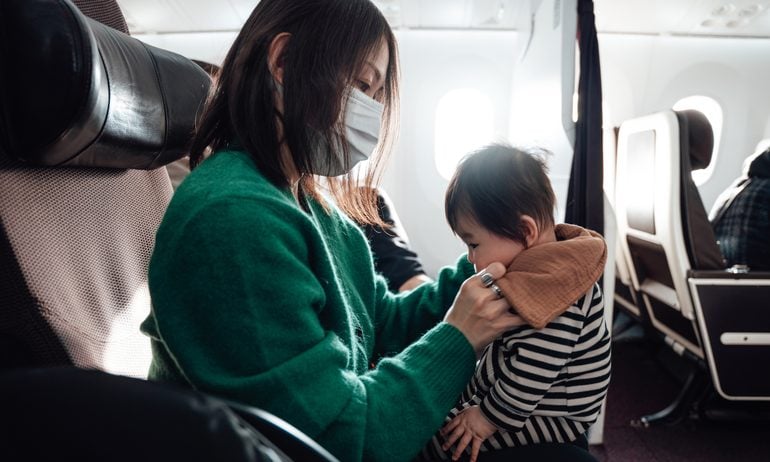How to Fly With Your Baby
Accepting help from strangers and feeding strategically can help make flying with an infant less stressful.

Many or all of the products on this page are from partners who compensate us when you click to or take an action on their website, but this does not influence our evaluations or ratings. Our opinions are our own.
Babies have such a bad reputation when it comes to staying quiet on plane rides that some parents go so far as to hand out treats to fellow passengers before the plane has even taken off. Indeed, George and Amal Clooney, world travelers and parents of twin babies, made headlines late last year for gifting headphones to some passengers, along with a note apologizing in advance for any crying.
While there’s no need to pack dozens of gifts in your diaper bag, travel and parenting experts recommend other strategies to increase your chances of a smooth flight when flying with an infant.
If you're flying with an older child — especially one who's mobile — guidelines and effective practices may be slightly different. See our tips for flying with toddlers and up.
Make sure your baby is old enough to fly
Airline policies vary widely. For example, United says infants must be at least seven days old to fly, while American Airlines says infants as young as two days old may fly, but will need a doctor’s approval if they are less than seven days old (upon request, airlines provide a form directly to the doctor).
Check with your airline about the rules in advance. You may also wish to consult your child's pediatrician.
Consider buying your baby a ticket
Children younger than 2 generally fly for free domestically because they can sit on caregivers’ laps (although you may need documentation, such as a birth certificate, to prove the child’s age). Still, the Federal Aviation Administration says that the safest way for children to fly is strapped into their own harness, which can be an approved car seat or other type of approved restraint. That way, during unexpected turbulence, the baby will be securely strapped in.
Plus, some parents may find that long flights can be easier when babies have their own space, especially if they can sleep in their car seat.
Regardless of whether you buy a ticket for your baby, children under 2 still need to be added to the airline reservation. And in some cases, especially on international flights, you may still need to pay infant fares and taxes. If you do buy a seat for your baby, some airlines, like Southwest, offer a reduced “infant fare.”
Plan around nap schedules
If you can get your baby to fall asleep on the plane, the flight may seem to go by more quickly — but many parents find that with the excitement of traveling, babies don't sleep at their usual times.
“We took a red-eye to Germany when our oldest daughter was around 2, and she didn’t sleep a wink. It was miserable,” says Kate Rope, author of “Strong As a Mother: How to Stay Healthy, Happy, and (Most Importantly) Sane From Pregnancy to Parenthood.”
After they arrived, they checked into their hotel early and took a family nap before heading out for sightseeing. That worked well for everyone, Rope says.
When booking your trip, try to find a flight itinerary that dovetails with your baby's preferred nap time. Also consider the potential benefits of a layover. Direct flights may get you and an upset baby to your destination faster, but a layover offers a chance to stretch, change and dispose of diapers, and feed your child more easily.
Check some of your gear
Babies tend to travel with a lot of stuff, including strollers, car seats, diaper bags and toys. It can be difficult, if not impossible, to carry it all along with your baby.
Check with your airline in advance about what you can check; in general, strollers and car seats can be checked for free. Bringing your car seat also eliminates the need to rent and install one if you are renting a car at your destination.
Some airlines allow families with young children to board before other passengers, which may offer you extra time to check and store all that gear. However, some may find it easier to skip the early-boarding option entirely to minimize the total time on the plane with a young child.
Pack extra clothes (for you, too)
Babies are known for eliminating bodily fluids at inconvenient times, and plane travel is no exception. Turbulence can also create a mess of knocked-over drinks and spilled food, and motion sickness can contribute to the chaos, too.
Packing extra clothes for both the baby and yourself can help reduce the chances of having to continue your trip in a soiled outfit.
Feed your baby during takeoff and landing
Just like adults, babies may experience discomfort in their ears as a result of air pressure changes during takeoff and landing; sucking and swallowing can ease the pain.
“When my daughters were breastfeeding, I would always breastfeed during takeoff and landing. Later, I brought sippy cups filled with milk,” Rope says. (In general, airport security allows parents to bring small amounts of liquids for babies, but they may need to examine or test it.)
She says that minimizing ear pain is one of the best ways to keep crying at bay.
Walk the aisles
“When they were babies, my husband and I would take turns walking up and down the aisle with them in a baby carrier when they got fussy,” Rope says.
Since babies are often soothed by movement as well as the roar of the plane engine, those strides can help stop the tears or even lull your baby to sleep. For your own comfort, be sure to wear supportive walking shoes.
Explore your surroundings
If your baby is old enough to enjoy grasping new things, the plane can serve as a new toy to explore, says Katherine Reynolds Lewis, author of the upcoming book “The Good News About Bad Behavior: Why Kids Are Less Disciplined Than Ever — and What to Do About It.”
“Point out all of the interesting trays and knobs, and maybe look out the window, too,” she says. Even in-flight magazines and barf bags can serve as intriguing new objects to supplement any toys and books you packed in the diaper bag. If you’re worried about germs, give everything a swipe first with antibacterial wipes from your bag.
Know that crying is normal
Kate Orson, author of “Tears Heal: How to Listen to Our Children,” urges parents to accept that crying, even on a crowded flight, is a normal part of being a baby and to some extent should be expected.
Other passengers probably don’t notice as much as you might think, given the engine noise, and they also might empathize with your plight, she says. “Many of your fellow passengers may be parents even if they don’t have their kids with them — we’ve all been there.”
Keep yourself calm and relaxed, too
“Try to pretend it’s just you and your baby on the plane. I’m sorry, but I can’t be worried about how upset Larry in 15D is,” says Farnoosh Torabi, a personal finance expert and mother of two kids.
Torabi and her husband recently traveled from New York City to Turks and Caicos with their 3-year-old and 10-month-old. “Babies can pick up on a parent’s stress, and that can only exacerbate the crying,” she says.
Accept help from strangers
Sometimes, when a flight attendant or fellow passenger notices an upset baby, they will offer to help by holding the child — and Torabi says it’s OK to accept this help.
“If someone offers to take over and try to soothe your baby, let them be your guest,” she says.
Flying with an infant, recapped
Flying with an infant requires an extra level of preparedness. Not only do you need to pack all-the-things, you will need to be strategic about selecting flights that best support baby's cycles (if you're lucky).
In the end, remember that you'll get through the flight (you've got this) and that accepting help from strangers can help soften the sting of a fussy kid.
How to maximize your rewards
You want a travel credit card that prioritizes what’s important to you. Here are some of the best travel credit cards of 2025:
Flexibility, point transfers and a large bonus: Chase Sapphire Preferred® Card
No annual fee: Wells Fargo Autograph® Card
Flat-rate travel rewards: Capital One Venture Rewards Credit Card
Bonus travel rewards and high-end perks: Chase Sapphire Reserve®
Luxury perks: The Platinum Card® from American Express
Business travelers: Ink Business Preferred® Credit Card
Chase Sapphire Preferred® Card
Travel
Dining
🔥 Huge highest-ever bonus on NerdWallet's 2025 Best All-Purpose Travel Rewards Card is back. Don't miss your rare chance to: Earn 100,000 points when you spend $5,000 on purchases in the first three months. That's worth at least $1,250 toward travel booked through Chase.


